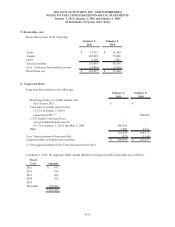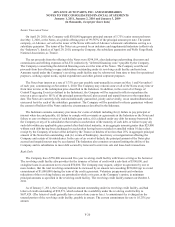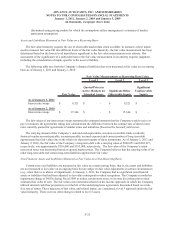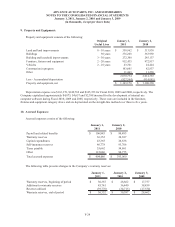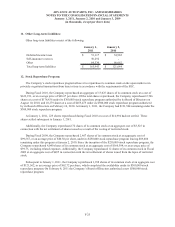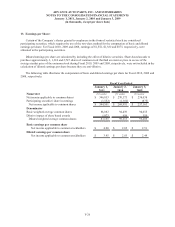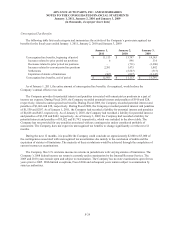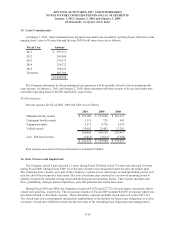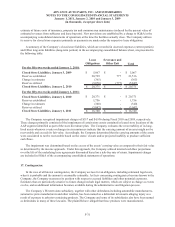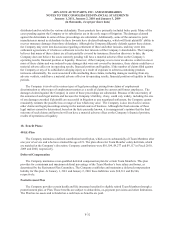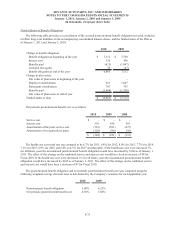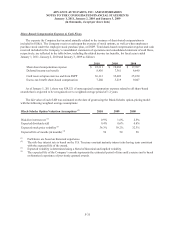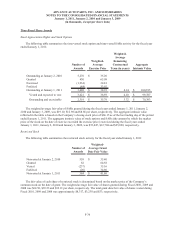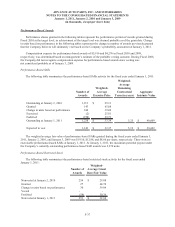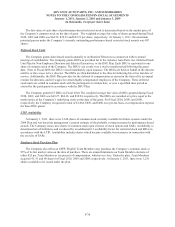Advance Auto Parts 2010 Annual Report Download - page 83
Download and view the complete annual report
Please find page 83 of the 2010 Advance Auto Parts annual report below. You can navigate through the pages in the report by either clicking on the pages listed below, or by using the keyword search tool below to find specific information within the annual report.
ADVANCE AUTO PARTS, INC. AND SUBSIDIARIES
NOTES TO THE CONSOLIDATED FINANCIAL STATEMENTS
January 1, 2011, January 2, 2010 and January 3, 2009
(in thousands, except per share data)
.
F-29
Unrecognized Tax Benefits
The following table lists each category and summarizes the activity of the Company’s gross unrecognized tax
benefits for the fiscal years ended January 1, 2011, January 2, 2010 and January 3, 2009:
January 1, January 2, January 3,
2011 2010 2009
Unrecognized tax benefits, beginning of period 11,113$ 13,797$ 14,145$
Increases related to prior period tax positions 6 896 514
Decreases related to prior period tax positions - (711) (1,280)
Increases related to current period tax positions 2,201 1,475 1,882
Settlements - (3,527) (317)
Expiration of statute of limitations (367) (817) (1,147)
Unrecognized tax benefits, end of period 12,953$ 11,113$ 13,797$
As of January 1, 2011, the entire amount of unrecognized tax benefits, if recognized, would reduce the
Company’s annual effective tax rate.
The Company provides for potential interest and penalties associated with uncertain tax positions as a part of
income tax expense. During Fiscal 2010, the Company recorded potential interest and penalties of $916 and $28,
respectively, related to unrecognized tax benefits. During Fiscal 2009, the Company recorded potential interest and
penalties of $1,066 and $18, respectively. During Fiscal 2008, the Company recorded potential interest and penalties
of $1,550 and $207. As of January 1, 2011, the Company had recorded a liability for potential interest and penalties
of $4,668 and $467, respectively. As of January 2, 2010, the Company had recorded a liability for potential interest
and penalties of $3,918 and $442, respectively. As of January 3, 2009, the Company had recorded a liability for
potential interest and penalties of $5,022 and $1,743, respectively, which was included in the above table. The
Company has not provided for any penalties associated with tax contingencies unless considered probable of
assessment. The Company does not expect its unrecognized tax benefits to change significantly over the next 12
months.
During the next 12 months, it is possible the Company could conclude on approximately $2,000 to $3,000 of
the contingencies associated with unrecognized tax uncertainties due mainly to the conclusion of audits and the
expiration of statutes of limitations. The majority of these resolutions would be achieved through the completion of
current income tax examinations.
The Company files U.S. and state income tax returns in jurisdictions with varying statutes of limitations. The
Company’s 2008 federal income tax return is currently under examination by the Internal Revenue Service. The
2009 and 2010 years remain open and subject to examination. The Company has no state examinations open for tax
years prior to 2005. With limited exceptions, Fiscal 2006 and subsequent years remain subject to examination by
state tax authorities.


